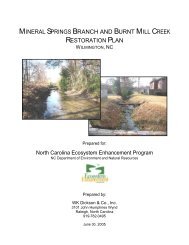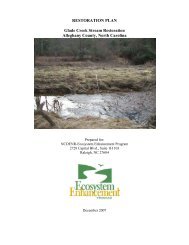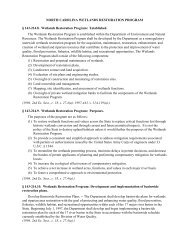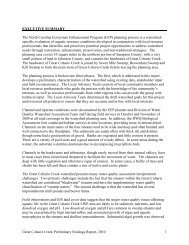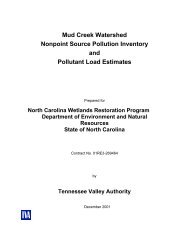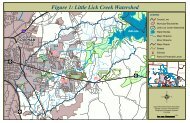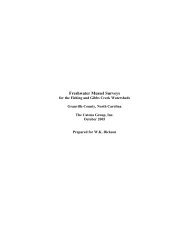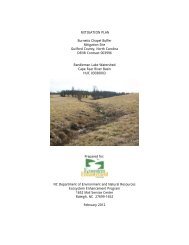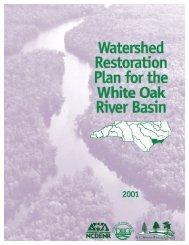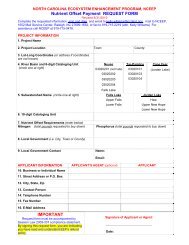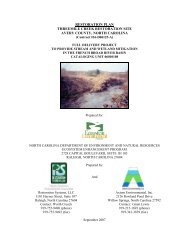Mud Creek Watershed Restoration Plan - Henderson County Center
Mud Creek Watershed Restoration Plan - Henderson County Center
Mud Creek Watershed Restoration Plan - Henderson County Center
You also want an ePaper? Increase the reach of your titles
YUMPU automatically turns print PDFs into web optimized ePapers that Google loves.
Backflow prevention for irrigation systems: Many farmers inject fertilizers or pesticidesinto their irrigation system to distribute chemicals across their fields. Unless the dosingpumps, which control the amount of chemicals injected into the irrigation system, arefitted with a backflow prevention device, the chemicals can backwash into the streamswhen the pumps are turned off. A back flow prevention device costs approximately$1000-$3000 depending on the farmers irrigation system. Farmers applying pesticidesthrough an irrigation system that pumps water directly from a stream should be requiredto install one of these devices. Until the State requires this practice, the <strong>County</strong> shouldcontinue to fund this practice through the Ag Cost Share Program.Removal of abandoned apple orchards: Although <strong>Henderson</strong> <strong>County</strong> has a long applegrowing tradition; many growers are abandoning their orchards for more profitableventures. Abandoned orchards are a breeding ground for pests that can migrate toadjacent orchards requiring growers to apply more pesticides. By removing abandonedorchards, the <strong>County</strong> can remove a potential source of insects thereby reducing theamount of pesticides applied to viable orchards. This practices costs $400/acre. Thereare approximately 1,000 acres of abandoned orchards in the <strong>Mud</strong> <strong>Creek</strong> watershed.<strong>Henderson</strong> <strong>County</strong> should work with landowners to voluntarily remove all abandonedorchards by 2005 and then remove newly abandoned orchards within 1 year ofabandonment.<strong>Henderson</strong> Soil and Water Conservation District (District) and <strong>Henderson</strong> <strong>County</strong>Cooperative Extension should develop new Agriculture Cost Share Practices to minimizepesticide drift and reduce pesticide use. The District is a leader in developing Ag Cost SharePractices to address pesticide management. The District should explore new technologies, suchas charged sprayers, that growers can use to reduce pesticide drift. The District should alsoencourage the use of riparian buffers along streams bordering apple orchards to help addresswater quality impacts from the arial drift of pesticides and promote organic apple farming as away to eliminate the risk of water quality degradation from pesticide contamination. Farmersmay need both technical and financial assistance to transition to organic methods. It takes threeyears to meet organic farming standards and during that time the District may need to provideincentive payments to growers through the Ag Cost Share Program.Cooperative Extensionshould assist with this effort by hosting a symposium on pesticide drift management targeted atissues specific to the apple industry.The <strong>Henderson</strong> Soil and Water Conservation District should work with landowners tostabilize streams near orchards to minimize the transport of historic pesticides. The TVAIPSI data indicate that there are over 30,000 feet of eroding streambanks adjacent to active andabandoned orchards concentrated in the Clear <strong>Creek</strong>, Lewis Fork, <strong>Henderson</strong> <strong>Creek</strong> and DevilsFork watersheds. Although there is funding available through the Ag Cost Share Program andthe Environmental Quality Incentives Program (EQIP) to stabilize streambanks, this practice isnot in great demand. Landowners need an incentive to participate. As an incentive, the <strong>County</strong>could pay 100% of the cost for this work if the landowners abandon their orchards and stabilizethe streambanks at the same time. The <strong>County</strong> should seek a grant for $100,000 to cover the25% cost share requirement traditionally paid by the landowners to stabilize 10,000 feet of theeroding banks adjacent to active and abandoned orchards.Section 3: Recommendations Page 38




